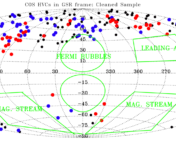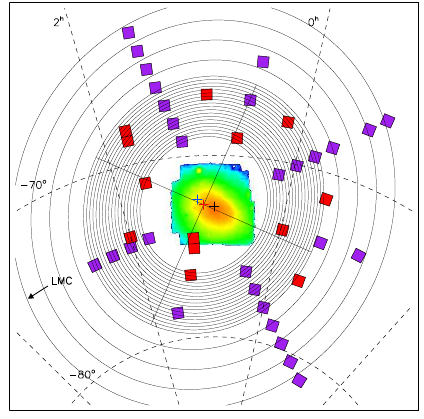Paper: The Structure of the Interstellar Medium of Star-Forming Galaxies
Authors: Philip Hopkins, Eliot Quataert, & Norman Murray
First Author’s Institution: UC Berkeley
Understanding the formation and evolution of galaxies is one of the main focuses of modern astrophysics. Observations of galaxies give us a snapshot in the evolution of a galaxy, allowing astronomers to infer the mass, size, star formation rate, metallicity, gas fraction, and dynamical state of galaxies throughout the visible universe. Unfortunately, we cannot directly observe how the interstellar medium (ISM) changes in time, and must use our physical understanding and deductive skills to infer how a galaxy evolves in time. Over the past twenty years or so, a major tool in this effort has been the direct numerical simulation of a star forming galaxy. For today’s astrobite, we will be discussing some of the highest-resolution simulations of isolated galaxies performed to date. Not only are these simulations high resolution, but they also include prescriptions to model several physical effects that previous galaxy evolution simulations have mostly ignored.

The distribution of stars (top two rows) and gas (bottom two rows) in the four simulations. The top two rows are calculated using the Starburst99 stellar population synthesis code. Dust obscuration is calculated self-consistently.
This paper discusses a suite of simulations of four galaxies with disparate physical properties. A snapshot in the evolution of each galaxy is depicted above and movies and more information on these simulations is available on Phil Hopkins’ website. The simulations encompass a large range of galaxy properties. The HiZ simulation is tuned to represent a gas-rich disk at z~2, the sorts of galaxies that are just now being resolved using Hubble and large ground-based telescopes. The Sbc simulation is tuned to match the properties of a low-redshift gas-rich starburst galaxy like M82. The MW simulation is set up to be similar to the Milky Way, and the SMC simulation has a mass and size corresponding to the Small Magellanic Cloud. All four galaxies are modeled with the same code and the same prescriptions for ‘feedback’ from star formation in the disk.
The feedback prescriptions are the real star of the show here. There are four separate ways in which the stellar populations of each galaxy can heat and push around gas in the simulations. First, the radiation pressure of newborn stars, winds from massive stars, and Type II supernova explosions can accelerate the gas in the neighborhood of star forming regions. Stellar winds recycle gas back into the simulation. Shock-heating from stellar-winds, photoionization heating due to the ionizing radiation of newborn massive stars, and shock-heating from supernovae bubbles also directly heat the gas, generating bubbles and filaments of hot gas. Lastly, the long-range radiation pressure force due to the combined luminosity of all of the stars in the galaxy is also included.
Most previous galaxy evolution simulations only included supernova shock-heating. Since stars form in dense gas, supernovae tended to explode within the dense gas of their natal star-forming region. Since the cooling time in dense gas is short, the energy injected from supernovae was very quickly radiated away, preventing the efficient feedback required by observations of star formation in nearby galaxies. To solve this problem, these simulations invoked a bit of a hack: they simply turned off the radiative cooling of gas for a short period of time in the neighborhood of supernova explosions, leading to a significantly higher amount of energy injection. The simulations in this paper do not need to turn off cooling, since radiation pressure and photoionization feedback clear out the dense gas in the neighborhood of massive stars by the time a supernova explosion occurs. In effect, these simulations no longer ignore the fact that stars shine.
The simulated galaxies match many of the observed properties, including the star formation rates, dynamical state of the stars, disk scale heights, degree of gravitational instability, and gas fractions, of the star forming galaxies the simulations are tuned to reproduce. Many previous simulations have done a good job of matching a few of these properties, but were unable to match all of them. One particular success of these simulations is the self-consistently generated galactic wind that each simulation exhibits. We know that there is a significant amount of metals in the intergalactic medium, and that the fraction of baryonic matter in galaxies is far too low given the amount of gas that should have fallen onto galaxies over cosmic time. This implies that galactic winds must be produced by all galaxies to drive gas out of galaxies and enrich the intergalactic medium with heavy elements. Indeed, for a long time now semi-analytic models of galaxy evolution have put in ‘by hand’ a prescription for mass ejection by galaxies to match the faint end slope of the luminosity function of star forming galaxies. These simulations produce such outflows by the action of only well-understood stellar feedback effects.
These simulations seem to suggest that to a large degree, the ISM self-regulates to always attain a marginally stable state. In simulations with weak feedback, gas collapses and turns into stars with a high efficiency, leaving only marginally stable gas. In simulations including feedback, only a small fraction of the gas is able to reach high densities before star formation disrupts the dense gas.





Really well written article, thanks!